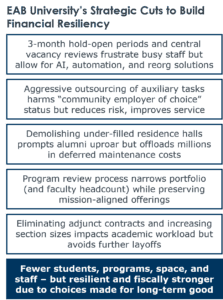Why leaner but stronger is the future of institutional operations
The last few years have been financially tough for higher education institutions. A perfect storm of financial pressures has impacted all universities, regardless of standing or region. Rising inflation, escalating operational costs, and declining enrollment are just some financial challenges leaders are juggling.
In a bid for stability, many institutions turned to across-the-board cuts to relieve pressures and find cost savings. However, these blanket cuts can damage a university’s strategic capacity, often causing more harm than good. Simply tightening the belt won’t suffice in the long term.
Here at EAB, we found that the most financially resilient universities have adopted a new approach. But what does this mean exactly? And how can leaders incorporate this “leaner but stronger” mindset into their higher education strategy?
What is “Leaner but Stronger?”
In the early 2000s, many institutions operated using a “more with more” mentality, engaging in a campus amenities arms race and an “if you build it, they will come” approach to program planning. The 2010s saw a shift to a “more with less” mindset. There was an emphasis on efficiency and belt-tightening to keep outputs constant, increase employee productivity, and make incremental improvements despite fewer resources.
But now, the most astute institutions are learning to scale back and prioritize their operations given shrinking resources and a declining student population. An Inside Higher Ed Survey of chief business officers revealed that the number of institutions aiming to be “smaller but better” increased from four percent in 2022 to 18 percent in 2023. Though still a small percentage, this sharp increase indicates a growing recognition of the need for strategic downsizing.
What Does “Leaner but Stronger” Look Like?
Unfortunately, there’s no single recipe for becoming a financially resilient institution. Below is a simplified example of what this proactive, thoughtful approach means, though. In our example university, they deployed a three-month hold open period that frustrated staff but allowed for a strategic reorganization. They aggressively pursued outsourcing auxiliary tasks, took down underutilized buildings to offload millions in deferred maintenance, and trimmed their program portfolio. Our example university learned to fit the needs of its market realities, resulting in a leaner, more resilient institution.

But this growth and scaling doesn’t come without some sort of cost. Staff, faculty, students, and alumni can become frustrated throughout this process as they may not understand the necessity of tough decisions. To mitigate negative reactions as much as possible, institutions must communicate the financial realities of their schools. This helps build stakeholder buy-in and trust in the necessary but unpopular decisions.
Learn how to align budget models to your strategic goals
What’s Right for Me?
There are dozens of different ways to strategically invest in your institution. Depending on location, size, and selectivity, some institutions need to be more aggressive, while others have the flexibility to pick and choose. The key point is not deferring the hard decisions to later when there will be fewer (and sometimes worse) options. Our Strategic Advisory Services helps leaders through financial challenges and more with a library of research-backed higher education strategies.

More Blogs

EAB Wrapped 2025: A year of reckoning—and reinvention—in higher ed

Fixing What’s Broken in Interdisciplinary Program Design
